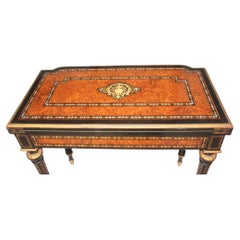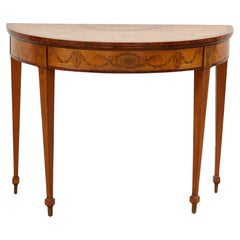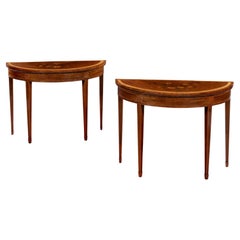Antiques Decorative Card Tables and Tea
to
1
Height
to
Width
to
Depth
to
1
1
1
1
1
1
1
1
1
1
1
1
Antique French Napoleon III Inlaid Card Table
Located in Seaford, GB
Antique French Napoleon III Inlaid Card Table
📜 Provenance – Napoleon III Period Inlaid Card Table, France, circa 1860
Sourced from a private collection in Lyon, this exceptional F...
Category
Antique Mid-19th Century French Napoleon III Card Tables and Tea Tables
Materials
Mother-of-Pearl, Walnut
$1,589 Sale Price
20% Off
Related Items
George III Inlaid Satinwood Card Table
By Mayhew & Ince
Located in Greenwich, CT
Very fine George III inlaid satinwood card table attributed to Mayhew and Ince, the top profusely inlaid with central shell, urns, swags, honeysuckle a...
Category
Antique 1780s English George III Game Tables
Materials
Kingwood, Satinwood, Tulipwood
Pair of George III Marquetry Inlaid Card Tables
By John Cobb
Located in Shipston-On-Stour, GB
A fine pair of 18th century George III Hepplewhite period floral marquetry inlaid demi-lune card tables attributed to John Cobb.
The semi-elliptical sabico and floral marquetry top is bordered and framed with a half moon of satin birch and box wood banding and crossbanded with an outer banding of tulipwood. The bouquet of flowers is most striking and displays some of the finest floral marquetry; the quality is exceptional and the detail and use of various exotic woods is exemplary.
The sabico frieze is shallow and crossbanded with tulipwood and flanked with inlaid satinwood flutes raised on crossbanded and tapered legs that stand on elegant block feet.
In excellent original condition and has achieved a warm and lightly sun kissed colour and patina to the premium grade figured mahogany.
Circa 1775 - 1785
John Cobb (c.1710–1778) was an English cabinetmaker and upholsterer. His work was once overshadowed by that of Thomas Chippendale but he is now regarded as being among England’s greatest furniture makers.
He is thought to come from Ashby, Norfolk and was the son of John Cobb and Mary Holmes.
It is believed that John Cobb was apprenticed in 1729 to Timothy Money (fl 1724–59), a Norwich upholsterer.
In 1755 he married Sukey, a daughter of the cabinetmaker Giles Grendey and is said to have acquired a ‘singularly haughty character’, strutting ‘in full dress of the most superb and costly kind...through his workshops giving orders to his men’, and on one occasion earning a rebuke from George III.
He worked with William Vile from 1750 until 1765 in premises at 72, the corner house of St Martin’s Lane and Long Acre. In the early 1750s, William Hallett, another cabinetmaker of the time, formed a working syndicate with Vile and Cobb. Vile and Cobb supplied furniture to the leading patrons of the day including George III and Queen Charlotte, the 1st Earl of Leicester at Holkham Hall, the 4th Duke of Devonshire at Chatsworth and the 4th Duke of Bedford at Woburn Abbey.
Vile and Cobb held the Royal Warrant from 1761 until April 1764 when Vile retired. While Vile created works in an Anglicised Rococo style, Cobb’s furniture of the 1770s was executed in an elegant Neoclassical style. Cobb was well known for his haughty disposition which did not always endear him to his customers, so it was no surprise that the Royal Warrant was awarded to two of their employees William France and John Bradburne instead of Cobb himself. Some of Cobb's work is in the Royal Collection at Buckingham Palace.
Following Vile's retirement in 1764, Cobb carried on in business with the assistance of his foreman, Samuel Reynolds (fl 1751–85). He made furniture to very high standards and earned a reputation for exquisite marquetry: Hester Thrale, the writer and friend of Dr Johnson, compared the inlaid floors at Sceaux, France, to ‘the most high prized Cabinet which Mr Cobb can produce to captivate the Eyes of his Customers’. Inlay in tropical woods, particularly satinwood, was an important element of Neo-classical furniture.
In 1772-4 Cobb produced an ‘Extra neat Inlaid Commode’ and two stands en suite for Paul Methuen at Corsham Court, Wilts, which survive in situ. In 1772 he was implicated in the smuggling of furniture from France. His most extensive work was for the 6th Earl of Coventry at Croome Court, Worcs, between 1765 and 1773. This included a large mahogany...
Category
Antique 1780s English George III Card Tables and Tea Tables
Materials
Mahogany, Satinwood, Sycamore, Tulipwood
Antique French quality kingwood marquetry inlaid ormolu mounted card table
Located in Ipswich, GB
Antique French quality kingwood marquetry inlaid ormolu mounted card table having a quality kingwood marquetry inlaid serpentine shaped swizzle top with a brass edge opening to revea...
Category
20th Century French Card Tables and Tea Tables
Materials
Serpentine, Brass, Ormolu
$2,281
H 29.73 in W 16.34 in D 33.08 in
George III Mahogany Card Table
By Adams
Located in Huntington, NY
Mahogany card table.
The serpentine-fronted top with canted corners opening to a baize-lined gaming surface
above the square tapering canted legs carved with a oval paterae.
I...
Category
Antique Late 18th Century English Adam Style Card Tables and Tea Tables
Materials
Mahogany
Antique George III Mahogany Card/Side Table
Located in Suffolk, GB
This is a George III antique mahogany card table with the loveliest inlaid mahogany top, original green baize and inlaid frieze. It stands ...
Category
Antique Early 19th Century English George III Card Tables and Tea Tables
Materials
Other
American Federal Inlaid Mahogany Card Table, 1800
Located in Astoria, NY
American Federal Inlaid Mahogany Serpentine Card Table, circa 1800, Baltimore of Philadelphia, with flip over top and gate leg extension. Extended: 28.25" H x 40.25" W x 36" D. Prove...
Category
Antique Early 1800s American Federal Card Tables and Tea Tables
Materials
Mahogany
Very Fine George III Card Table
By Paul Saunders
Located in Greenwich, CT
Very fine Georgian mahogany card table possibly by Paul Saunders, with shaped and molded serpentine top with baize lined interior and concertina action, ...
Category
Antique 1760s English Chippendale Card Tables and Tea Tables
Materials
Mahogany, Oak
George III Mahogany Concertina Card Table
Located in New Orleans, LA
This phenomenal Georgian concertina card table is a masterpiece of English woodworking. Constructed for multifunctional use, this mahogany table ...
Category
Antique 18th Century Irish George III Card Tables and Tea Tables
Materials
Mahogany
ANTIQUE FRENCH NAPOLEON III 1850 EBONiSED BOULLE CARD TABLE FOR RESTORATION
Located in West Sussex, Pulborough
Royal House Antiques
Royal House Antiques is delighted to offer for sale this totally original, unrestored, Napoleon III Boulle card games table with ebonised frame and green baize playing surface
Please note the delivery fee listed is just a guide, it covers within the M25 only for the UK and local Europe only for international, if you would like an accurate quote please send me your postcode and I’ll provide you with the exact price
A very expensive and collectable mid 19th century Boulle table...
Category
Antique 1850s French Napoleon III Card Tables and Tea Tables
Materials
Wood
$3,768
H 30.52 in W 37.41 in D 18.63 in
Victorian Burr Walnut Inlaid Card Table
Located in Chelmsford, Essex
For sale is a very good quality Victorian burr walnut inlaid card table. The top swivels and folds over to reveal a a baise lined interior. Standing on elegantly turned legs decorate...
Category
Antique 19th Century English Card Tables and Tea Tables
Materials
Walnut
George III Mahogany Card Table
Located in Reepham, GB
A fine mid-18th-century rich mahogany George III card table raised on cabriole legs with ball and claw feet, scallop shells carved in high relief on all four legs with swags, support...
Category
Antique 18th Century George III Card Tables and Tea Tables
Materials
Mahogany
Antique Victorian Mahogany & Inlaid Card Games Table 19th Century
Located in London, GB
This is a fabulous antique Victorian mahogany, satinwood and marquetry games table in the manner of Edwards & Roberts, circa 1860 in date.
It is made of beautiful flame mahogany and satinwood with elegant satinwood inlaid and penwork floral and foliate decoration of ribbons, bellfowers and garlands..
The shaped hinged top opens to reveal a fabulous green baize lined gaming interior for playing cards, above a frieze fitted with a drawer and decorated by a beautiful classical urn. The table is raised on elegant square tapering legs terminating in spade feet.
It is an elegant piece which will enhance a special room in your home.
THE BOTANICAL NAME FOR THE MAHOGANY THAT THIS ITEM IS MADE OF IS SWIETENIA MACROPHYLLA AND THIS TYPE OF MAHOGANY IS NOT SUBJECT TO CITES REGULATION AND DOES NOT CONTAIN ANY RESTRICTED MATERIALS.
Condition:
In excellent condition having been beautifully cleaned and polished in our workshops, please see photos for confirmation.
Dimensions in cm:
Height 74 x Width 89 x Depth 48
Dimensions in inches:
Height 2 foot, 5 inches x Width 2 foot, 11 inches x Depth 1 foot, 7 inches
Marquetry
is decorative artistry where pieces of material (such as wood, pewter or brass silver) of different colours are inserted into surface wood veneer to form intricate patterns such as scrolls or flowers.
The technique of veneered marquetry had its inspiration in 16th century Florence. Marquetry elaborated upon Florentine techniques of inlaying solid marble slabs with designs formed of fitted marbles, jaspers and semi-precious stones. This work, called opere di commessi, has medieval parallels in Central Italian "Cosmati"-work of inlaid marble floors, altars and columns. The technique is known in English as pietra dura, for the "hardstones" used: onyx, jasper, cornelian, lapis lazuli and colored marbles. In Florence, the Chapel of the Medici at San Lorenzo is completely covered in a colored marble facing using this demanding jig-sawn technique.
Techniques of wood marquetry were developed in Antwerp and other Flemish centers of luxury cabinet-making during the early 16th century. The craft was imported full-blown to France after the mid-seventeenth century, to create furniture of unprecedented luxury being made at the royal manufactory of the Gobelins, charged with providing furnishings to decorate Versailles and the other royal residences of Louis XIV. Early masters of French marquetry were the Fleming Pierre Golle and his son-in-law, André-Charles Boulle, who founded a dynasty of royal and Parisian cabinet-makers (ébénistes) and gave his name to a technique of marquetry employing brass with pewter in arabesque or intricately foliate designs.
Edwards & Roberts
The firm Edwards & Roberts was one of the best English antique furniture cabinet makers of the second half of the eighteenth century. The company was founded in 1845 and by 1854 was trading as ‘Edwards & Roberts’, 21 Wardour Street, Antique and Modern Cabinet...
Category
Antique 1860s English Victorian Card Tables and Tea Tables
Materials
Mahogany, Satinwood
$4,590
H 29.14 in W 35.04 in D 18.9 in


